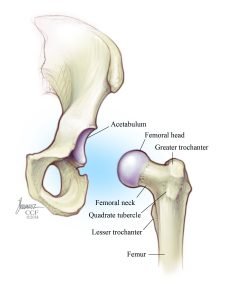Hip Flexor
 A group of muscles compose the hip flexor or iliopsoas. Located at the top of the thigh, hip flexors contain the iliacus muscle, the psoas major muscles, and the rectus femoris. Hip flexors allow the leg to flex inwards towards the hips and provide stability to the hip. The hip flexors activate with daily function during activities like walking, getting in and out of cars, and even putting on shoes and socks. When an injury occurs to the hip flexor, not only can it be extremely painful for the patient, but day to day tasks prove very difficult with an injured hip flexor.
A group of muscles compose the hip flexor or iliopsoas. Located at the top of the thigh, hip flexors contain the iliacus muscle, the psoas major muscles, and the rectus femoris. Hip flexors allow the leg to flex inwards towards the hips and provide stability to the hip. The hip flexors activate with daily function during activities like walking, getting in and out of cars, and even putting on shoes and socks. When an injury occurs to the hip flexor, not only can it be extremely painful for the patient, but day to day tasks prove very difficult with an injured hip flexor.
Symptoms of hip flexor injuries
The most common injuries that occur to the hip flexor include hip flexor strains and hip flexor tears. Typically hip flexor strains and tears occur due to overusing one of or multiple of the three muscles that create the hip flexor. When the hip flexor tears, the tear can occur at three different grades. For a grade one tear of the hip flexor, only a few muscle fibers have damage. In a grade two tear of the hip flexor, a moderate amount of muscle fibers have damage. In a grade three tear of the hip flexor, the muscle fibers suffer a complete tear. Both grade two and grade three tears of the hip flexor can result in serious pain and limitation.
Symptoms of a hip flexor strain or tear include:
- Sharp pain in the hip or pelvis area
- Swelling and bruising around the hip area
- Inability to walk without a limp or flex the leg without pain
- Cramping in the hip or pelvis area
- Sudden and marked hip pain
Diagnosing and treating hip flexor injuries
Patients should always seek medical advice from an orthopedic hip specialist when suspecting a hip flexor injury. If left untreated, hip flexor injuries may lead to other ailments including a hip labral tear, osteoarthritis, or atrophy of muscles.
To diagnose a hip flexor injury, doctors start with conducting a physical examination. During a physical examination, doctors ask the patient about any medical and family history. In addition, physicians ask the patient about their daily activities and when and how the injury may have occurred. The physician also performs physical tests. The physician often moves the leg around to see which movements cause pain and to what degree.
Next, the orthopedic specialist likely order diagnostic testing. Diagnostic testing may include X-Ray, MRI, or even a CT scan in order to rule out any other injuries to the hip region or pelvis. In most instances of a hip flexor strain or low grade tear, the doctor advises the patient to rest and ice the hip flexor area. They may also suggest that the patient goes to physical therapy to learn to properly stretch and strengthen the muscles. In the case of persistent injury  to the hip flexor, severe tear, or a hip impingement, the physician may suggest surgical intervention.
to the hip flexor, severe tear, or a hip impingement, the physician may suggest surgical intervention.
To view a list of all insurances that AOA Orthopedic Specialists accept, click HERE. To schedule an appointment online, click HERE.

